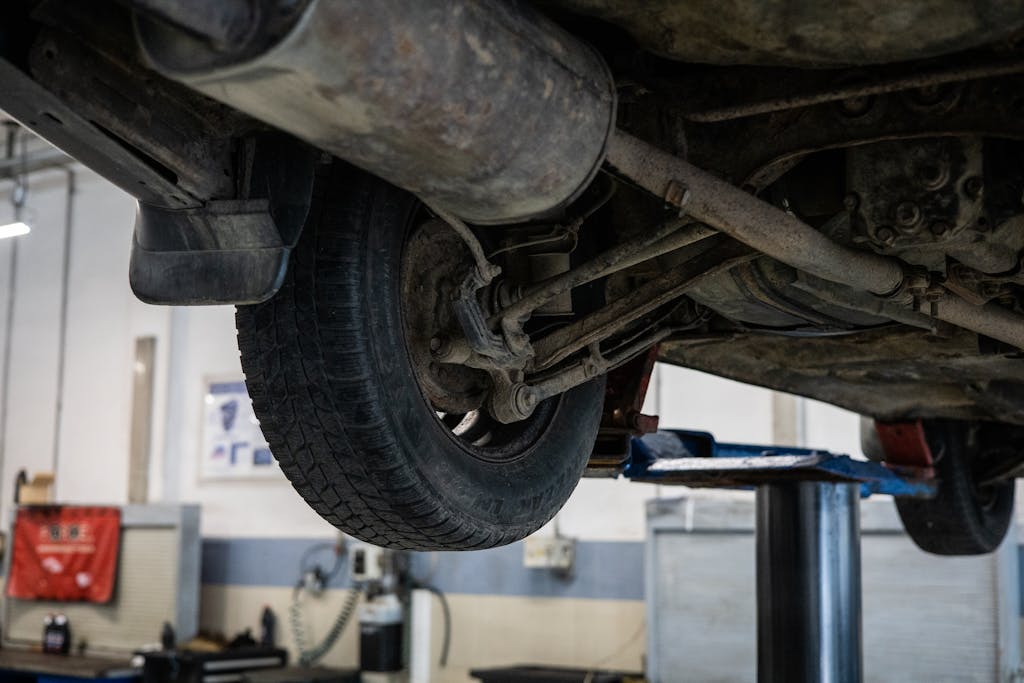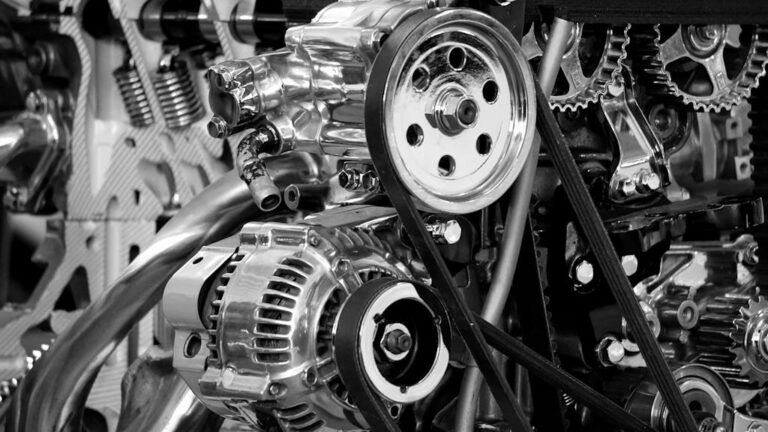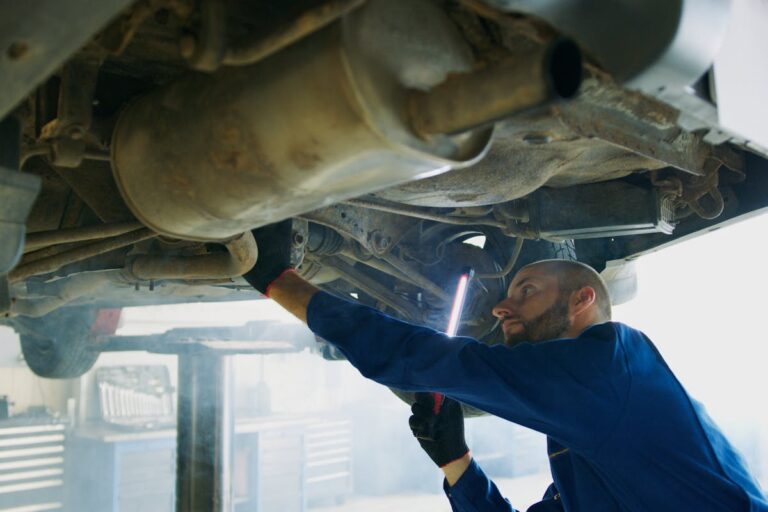How to Tell If Your Suspension Is Damaged
Recognizing signs of suspension damage is essential for vehicle safety and performance. Unusual noises, like knocking or creaking, can indicate underlying issues. Uneven tire wear suggests alignment problems, while changes in vehicle handling and ride height may hint at compromised components. Excessive bouncing and fluid leaks further point to suspension woes. Understanding these indicators enables timely intervention, ensuring control and stability. Curious about detecting these symptoms in detail? There’s much more to uncover.
Recognizing Unusual Noises
Unusual noises emanating from a vehicle can often serve as early indicators of suspension damage. A damaged suspension system may produce knocking, clunking, or creaking sounds during normal operation. These auditory signals typically originate from worn-out components such as bushings or ball joints. When a driver experiences feeling unusual sensations, such as excessive bouncing or swaying, it may correlate with detecting unusual movements in the vehicle’s suspension. Such anomalies can amplify auditory symptoms, indicating potential deterioration. The suspension system’s primary function is to absorb shocks and maintain vehicular stability; consequently, any deviation in operational sound should prompt inspection. Technicians can further diagnose by focusing on these noises, determining the root cause, and ensuring the suspension system remains functional and safe.
Identifying Uneven Tire Wear
Identifying uneven tire wear is vital for diagnosing potential suspension damage. Key indicators include noticeable tire tread depth differences and abnormal wear patterns, which may suggest improper weight distribution. Such irregularities often point to misalignment issues, necessitating further inspection of the suspension system.
Tire Tread Depth Differences
One of the most telling indicators of potential suspension damage is uneven tire wear, specifically when differences in tread depth are noticeable across the tires. Tire tread depth variations can signal issues in the vehicle’s suspension system, as it affects how the tires contact the road surface. When the suspension is compromised, it may lead to uneven tread wear patterns, which can manifest as varying depths in tread across the tire or between different tires. Technicians use precise measurement tools to assess tread depth and identify anomalies. A notable disparity in tread depth often suggests misalignment or worn suspension components, necessitating further inspection. Regular monitoring of tread depth is essential for maintaining ideal tire performance and ensuring vehicular safety.
Abnormal Tire Wear Patterns
How can one recognize abnormal tire wear patterns? Identifying irregular tire tread patterns is essential in diagnosing potential suspension issues. Uneven tire wear often manifests as excessive tire wear on one side of the tire, creating a noticeable difference in tread depth. Patterns such as cupping, feathering, or scalloping indicate that the tire is not maintaining consistent contact with the road surface. This irregularity can result from defective suspension components, which may compromise vehicle handling and safety. Regularly inspecting tires for these signs is indispensable for maintaining ideal performance. Excessive tire wear not only shortens tire lifespan but can also signal underlying suspension damage, necessitating prompt attention to prevent further automotive complications. Ensuring tires wear evenly can enhance vehicle stability and prolong tire usability.
Misalignment Indicators
When might a vehicle owner suspect misalignment as a cause of uneven tire wear? Uneven tire wear can be a clear indicator of faulty alignment and poor shock absorption. It is vital to identify these signs early to prevent further damage. Some misalignment indicators:
- Feathering: Tires appear smooth on one side and sharp on the other, often due to faulty alignment.
- Camber Wear: Uneven tread wear on the inner or outer edges of the tire, suggesting poor shock absorption or alignment issues.
- Toe Wear: Excessive wear on both inner or outer edges of tires, typically resulting from misaligned wheels.
- Cupping: Scalloped dips on the tire surface, frequently caused by defective suspension components, leading to poor shock absorption.
Detecting these patterns early guarantees proper vehicle maintenance.
Monitoring Vehicle Handling
Monitoring vehicle handling is essential for detecting potential suspension damage, as it directly affects the car’s performance and safety. Uneven tire wear may indicate improper alignment or suspension issues, impacting traction and fuel efficiency. Additionally, unstable steering control, such as excessive vibrations or difficulty maintaining a straight path, can signify worn or damaged suspension components.
Uneven Tire Wear
Uneven tire wear is a critical indicator of potential suspension damage that can affect a vehicle’s handling and safety. Irregular tread wear patterns can arise from misaligned suspension components, causing one section of the tire to wear faster than others. This irregularity often leads to premature tire replacement, increasing maintenance costs. Monitoring tire wear patterns can reveal underlying suspension issues.
- Cupping: This scalloped wear pattern is often due to worn shock absorbers or struts, indicating suspension issues.
- Feathering: Uneven edges on tire tread suggest poor alignment, necessitating suspension inspection.
- Camber Wear: Excessive wear on one side of the tire points to possible camber misalignment in the suspension.
- Toe Wear: Uneven wear across the tire width is often related to incorrect toe settings, implicating suspension adjustments.
Unstable Steering Control
Irregular tire wear can also correlate with issues in steering stability, another telltale sign of compromised suspension. When a vehicle exhibits unstable steering control, it often indicates underlying suspension problems. One might observe irregular wheel movement, where the steering feels loose or unresponsive. This condition can result from worn-out components such as ball joints, tie rods, or control arms. Such deterioration leads to unpredictable vehicle behavior, especially at higher speeds or during cornering, posing significant safety risks. Additionally, uneven distribution of weight due to suspension defects can cause the vehicle to veer unexpectedly, requiring constant corrections by the driver. Monitoring these signs is essential for maintaining vehicle handling integrity and ensuring a safe driving experience, thereby preventing potential accidents.
Observing Changes in Ride Height
A telltale indicator of potential suspension damage is a noticeable change in the vehicle’s ride height. Variations in ride height can suggest issues with suspension components such as coil springs. Inspecting coil springs for deformities or fractures is imperative, as these can directly affect the vehicle’s stance. Monitoring suspension components regularly guarantees that any deviations are promptly addressed. Consider the following checklist:
- Measure Ride Height: Use a tape measure to compare the vehicle’s height from the ground to fender on each side.
- Inspect Coil Springs: Look for breaks or uneven settling, which can cause tilting.
- Check for Leaks: Examine shock absorbers for fluid leakage, indicating failure.
- Evaluate Bushings and Joints: Worn components can lead to uneven height, affecting ride quality.
Noticing Excessive Bouncing
While changes in ride height provide initial clues of suspension issues, the behavior of the vehicle over uneven surfaces offers further insight. Abnormal bouncing is a vital indicator of potential suspension damage. Under normal conditions, a vehicle should stabilize quickly after encountering a bump or dip. However, if the vehicle exhibits excessive movement, continuing to bounce several times before stabilizing, it may suggest worn or damaged suspension components. Shock absorbers, in particular, play an essential role in dampening movement. Faulty shocks can lead to prolonged oscillations, compromising vehicle control and comfort. A simple test involves pressing down firmly on the vehicle’s hood or trunk; if it continues to bounce excessively, professional evaluation of the suspension system is advised.
Examining Leaking Fluids
When evaluating potential suspension issues, inspecting for leaking fluids can provide critical information about the condition of the system. Fluid leaks often indicate that seals or gaskets may be compromised, affecting suspension performance. Observing the color and consistency of the fluid is essential, as fluid discoloration may suggest contamination or wear. To thoroughly examine for leaking fluids, consider the following:
- Check under the vehicle: Look for fluid puddles, particularly beneath the shock absorbers or struts.
- Inspect shock absorbers and struts: Identify any visible leaks, indicating potential issues.
- Evaluate fluid color: Discolored or milky fluid can signal contamination or degradation.
- Monitor fluid levels regularly: Low levels might suggest a persistent leak requiring attention.
Accurate identification of fluid leaks can lead to timely repairs and best suspension performance.
Detecting Steering Wheel Vibration
How can one ascertain the cause of steering wheel vibration, a common indicator of potential suspension issues? Initially, examine if the vibration arises during specific driving conditions, such as high speeds or uneven terrains. This can help isolate whether the issue originates from the suspension. Sudden jerking motions during steering can suggest misaligned wheels or an unbalanced suspension system. Additionally, evaluate the steering for excessive play in steering, which may point to worn suspension components or loose connections. Consistent vibrations, especially when paired with these symptoms, often necessitate a thorough inspection of the suspension system. By addressing these factors, one can determine whether the vibration is indeed a symptom of underlying suspension damage, aiding in prompt, effective maintenance.
Checking for Visible Damage
Inspecting a vehicle for visible damage to the suspension system requires a systematic approach to guarantee accuracy and effectiveness. A thorough visual inspection involves examining suspension components closely to identify potential damage. Key areas to focus on include:
- Shock Absorbers and Struts: Look for leaks, dents, or rust, which may indicate compromised integrity.
- Springs: Check for signs of sagging or misalignment, which could affect vehicle stability.
- Control Arms and Bushings: Inspect for cracked parts or excessive wear, as these components are pivotal for maintaining proper wheel alignment.
- Ball Joints and Tie Rods: Confirm these parts are free from cracks or deformation, essential for steering precision.
Systematic examination will help confirm the suspension system functions effectively.
Assessing Braking Performance
Evaluating braking performance is a critical aspect of gauging a vehicle’s overall safety and functionality, especially in the context of suspension health. A compromised suspension can adversely affect brake pedal performance, leading to increased stopping distances or uneven braking. During a brake system inspection, it is essential to check for signs of wear or damage that might stem from suspension issues, such as uneven brake pad wear or fluid leaks. The brake pedal should respond promptly and smoothly; any sponginess or excessive travel may indicate underlying problems. Additionally, the vehicle’s tendency to pull to one side during braking should be noted, as this could suggest misalignment linked to suspension damage. A thorough examination guarantees both braking efficiency and suspension integrity are maintained.
Frequently Asked Questions
How Often Should Suspension Components Be Inspected or Replaced?
Suspension components should undergo inspection every 12,000 miles or annually, whichever comes first. A professional evaluation guarantees proper functioning. Regular inspection intervals prevent potential issues and maintain vehicle safety and performance, reducing the risk of costly repairs.
Can Damaged Suspension Affect Fuel Efficiency?
Yes, damaged suspension can lead to decreased gas mileage due to misalignment and increased rolling resistance. Additionally, it can cause early component wear, as parts endure more stress without proper suspension support, further impacting fuel efficiency.
What Are the Main Causes of Suspension Damage?
Suspension damage primarily results from excessive wear due to prolonged use, road conditions, or heavy loads. Improper installation can also contribute, as incorrect component alignment may lead to premature deterioration, affecting vehicle stability and handling efficiency.
How Does Weather Impact Suspension Health?
Weather impacts suspension health through excessive moisture exposure, leading to rust and corrosion, and extreme temperature variations, causing metal fatigue. These conditions deteriorate suspension components, reducing vehicle stability and increasing the likelihood of mechanical failures.
Are There Specific Tools Needed to Diagnose Suspension Issues?
Specific tools for diagnosing suspension issues include suspension diagnostic tools like a ball joint press, spring compressor, and shock absorber tester. These are essential for thorough suspension component inspection to identify wear, misalignment, or damage accurately.



